“We Were Growing Something There”: An Oral History of Annihilation and the Resurrection of Marvel Cosmic
In 2006, Marvel released its greatest event comic ever.
It was a title that had lasting ramifications on the Marvel universe, both in the comics and the Marvel Cinematic Universe, changing the way we think of a huge amount of characters in the process.
That comic was Annihilation.
This event series, released in the shadow of the much-ballyhooed Civil War in the same year, found the entirety of Marvel’s cosmic universe under threat of Fantastic Four villain Annihilus, as he burst from the Negative Zone with his Annihilation Wave to devastate much of known space. Told over a one-shot, four mini-series and a core six-issue story – as well as a pair of oft forgotten antecedents – the hope was to tell a good story with underutilized characters.
What it did was reignite a dormant but essential section of the House of Ideas.
This is the story of the efforts of a rather persistent editor, his legendary partner-in-crime, and a slew of other talented creators, and how this event spawned a bright new future for the cosmic side of the Marvel universe in both comics and film.
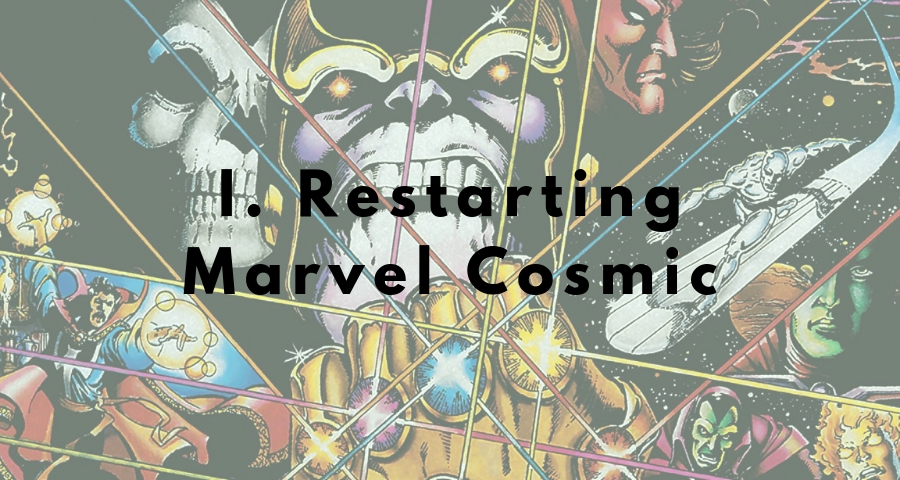
Coming off Infinity Gauntlet, Infinity War and Infinity Crusade in the early 1990s, the Marvel cosmic universe began to fall into the background. The galaxy spanning tales of Jim Starlin, George Perez and Ron Lim were replaced with a push towards more street level stories, especially with the rise of the Marvel Knights imprint and Joe Quesada’s ascension to Editor-in-Chief in 2000. All was quiet on the cosmic front.
Tom Brevoort (then Marvel Heroes group editor): Honestly, (Marvel cosmic) wasn’t much of anywhere. There had been an occasional project over the years, but it had been a while since there’d been any great concentration of interest and effort in the cosmic characters.
Andy Lanning (co-writer of Annihilation: Nova): For the best part of almost ten years, there was almost nothing. There was the odd Starlin Thanos thing here or there. But there was no sustained cosmic set of titles.
Brevoort: A lot of that came down to Joe Quesada and his tastes—Joe’s made no secret of the fact that, by and large, the cosmic side of the Marvel Universe didn’t speak to him as directly as some of the other characters did, so while we’d occasionally dabble in those fields, there wasn’t a great deal of effort being expended on it overall.
Dan Abnett (co-writer of Annihilation: Nova): The Marvel editorial top brass, particularly Joe Quesada, love him to death, would say, “I do not get cosmic. I don’t get why people like this stuff.” He was almost proud of this. In fact, the character Jack Flagg in Guardians – who goes around being the Earthman bewildered by the cosmic stuff – was a kind of nod in Joe’s direction.
While others might have seen an environment in which a specific type of comic did not appeal to the editor-in-chief as an insurmountable challenge, Marvel editor Andy Schmidt saw an opportunity. With low levels of faith come low expectations, one might say. As a young editor, Schmidt had designs on the cosmic side of the universe.
Andy Schmidt (editor of the Annihilation event): I had built confidence in my skills as an editor. So I was looking for something I could take the reins on. And Marvel cosmic just wasn’t selling. And so that was a place where I was like, “Well, this is an area where I can hunt.” I had been formulating ideas and trying to convince Marvel to let me do a big event out in outer space. “Why would we do that?” (laughs) “Well, I can’t argue with that, except what I’m saying is it would be good?” (laughs)
Abnett: He was really carving out a space in which a Marvel cosmic event featuring the less famous Marvel cosmic characters could even happen in the first place.
Schmidt: There were several different versions of events that I had pitched that went nowhere. The fact that I kept pitching it eventually got me the status of like, “Well, if anything comes in Marvel cosmic, give it to Andy to review.” And the one thing we had was that Thanos book.
Launched in 2003 in Brevoort and Schmidt’s Marvel Heroes office, Thanos reunited writer Jim Starlin and his previous collaborator Al Milgrom 1 with Starlin’s legendary villain from Titan. It was not destined to be a long run. But its brevity opened a door to bring in Schmidt’s most important cosmic collaborator: Keith Giffen.
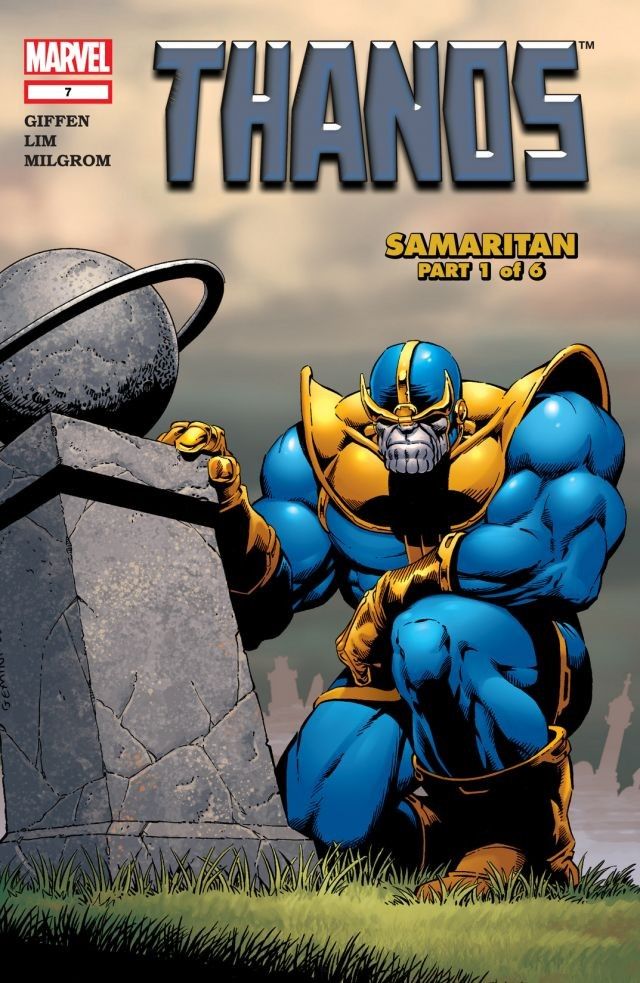
Schmidt: We were doing the Thanos book in our office, and so when Jim (Starlin) left that book, Tom and I didn’t really have a game plan. We knew issue #7 had to come out. And so I turned around in the office and said, “Hey Tom, I loved when Keith Giffen did Legion of Super-Heroes. I’ve always wanted to work with him. What do you think of giving him a call?” And Tom kind of thought about it and was like, “Sure, go for it.” So I looked him up and called him.
Keith Giffen (writer of Annihilation, Annihilation: Silver Surfer, Annihilation Prologue): I called Starlin when they asked me if I wanted to do Thanos when he was leaving. I asked for his permission to do it because that character is so much his character that I felt awkward unless he sort of gave his blessing. If he said, “No, I’d really rather you wouldn’t,” I wouldn’t have done the book.
While Giffen, Schmidt, Lim and Milgrom teamed up for Samaritan, the six issue arc that closed out that volume of Thanos’ solo book,2 Schmidt was still pitching a version of Annihilation in its infancy. It almost happened much earlier than we saw it and with a different writer at its helm.
Schmidt: At one point, we were in a Marvel editorial retreat, where we figure out the tent poles of Marvel’s publishing plan for the next 18 months or so. In one of those meetings I had pitched all this Marvel cosmic stuff. And there was something in whatever I said that day that JMS 3 reacted to. And he was like, “I’d like to do it.” There was a day or two where it looked like JMS was going to helm the whole thing.
Giffen: The original plan for Annihilation was we didn’t have the Silver Surfer. We couldn’t use the Silver Surfer because JMS was (doing) a Silver Surfer thing that was going to be a big deal at Marvel. When he found out about it, Straczynski was the one who contacted Andy Schmidt and said “No, you can’t do this without the Silver Surfer. You do it.”
Schmidt: Where JMS wound up landing was he was just going to do a four issue Silver Surfer mini-series, which came out as Silver Surfer: Requiem. (Which was) really good but not at all what I pitched. It didn’t step on my toes at all other then it basically delayed anything I was going to do by a year because Silver Surfer was now off the map, because JMS and Esad were doing this painted book.
During the time where Silver Surfer was otherwise occupied, Schmidt and Giffen were building a relationship thanks to their work together on Thanos and another project that was essential to the foundation of the brewing cosmic event.
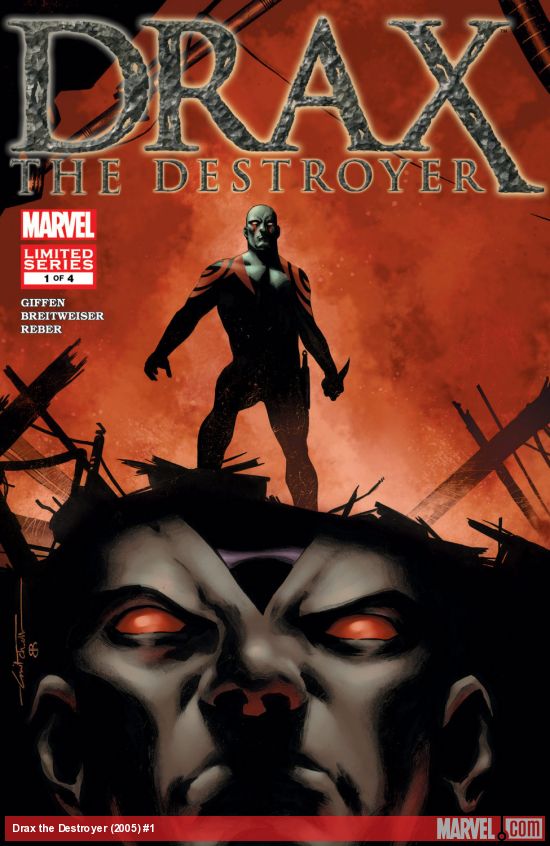
Schmidt: I kind of brought Keith in as the sort of, “See, Keith is doing cool stuff in Thanos, and now that Thanos is being canceled just six issues later, I’d like to keep working with him.” And we had this idea for this (event), and they were like, “Well, we’re not going to approve the big thing, but pitch us a four issue mini-series or something.” That’s when I pitched Drax. 4
Giffen: Drax was the series that proved to me that I can go in and play with these characters without burning what’s gone before. If Annihilation is looked at as a meal, Drax was the appetizer that made me want the meal.
Schmidt: I didn’t want to try to cram this giant event into four issues. So for four issues, I was like, “I’m going to take one character and we’re going to focus on that character and reinvent that character.” The proof of concept was really, “this is the type of thing that I’m talking about doing. This is not Drax the Destroyer where he’s got his Dracula cloak and he’s a blithering idiot.”
Giffen: Drax was a guy that was running around in a weird costume with a skull and crossbones on his belt, and he seemed kind of directionless. He was this big strong guy who just showed up and went “DRAX SMASH!” We already have a guy who runs around yelling smash. We’ve got a Hulk. He’s green. It was too close for me.
Schmidt: The idea of Drax is he was created to track down and kill Thanos. If you were going to create somebody to track down and kill the smartest, most badass bad guy in the universe, you wouldn’t create an idiot. My take on it was, “Well, we’ll say there was a glitch in the process.” So when he dies in the mini-series and goes into the cocoon, it restarts that whole thing. He’s not as physically powerful, but (when) he comes out, he’s this ultimate fighting machine but in outer space. If you were going to send someone to kill somebody else, you’d send Rambo, not The Hulk. It showed, “This is the type of thing we’re trying to do when we reinvent the characters. We want to go back to their core and reinvent them for today.”
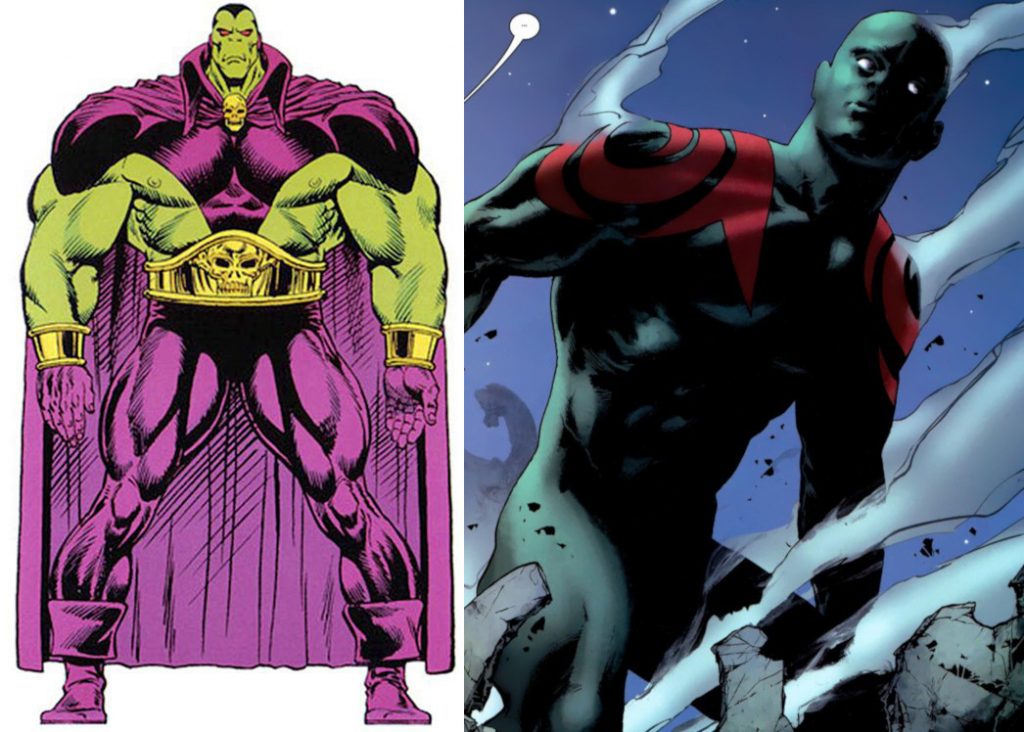
Giffen: I was up at Marvel and Andy pulled me into this small meeting room, and he started telling me about (Annihilation), and then I said, “Yeah, I’d be interested.” What appealed to me about doing Annihilation was the chance to dust off some of these characters and try in my own plodding way to make these characters valid for a new audience. And we sort of ran with it from there. My job was to think about it and think about it the way Andy put it. “Revitalize the cosmic characters. A big cosmic war. Keep Earth out of it.”
Schmidt: While we were doing that, the sales of Drax were not great. But what we got was this feedback from readers and retailers that people were really digging it. The feedback was there was something there. Which was just enough, along with how long I had been pushing how I wanted to do this and I was getting more creators interested. All of that combined on Drax was just enough to get Annihilation green lit.
To underline how different comics were at the time, the actual Annihilation event wasn’t even announced until the back of Drax the Destroyer #4, less than three months before the arrival of the Prologue that was set to kick the whole thing off. To make it all work, though, there was one last thing they had to do: change the ending of the mini-series to make it lead into Annihilation, carrying Drax and a surprise favorite of Giffen’s from the mini into the center of the cosmic event.
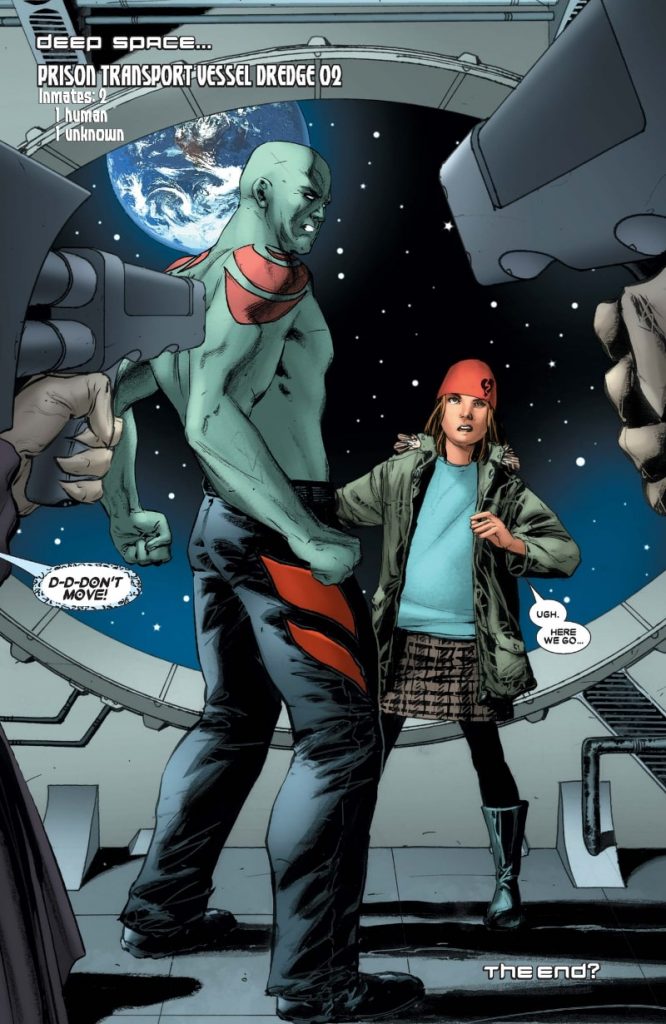
Giffen: Cammi was just supposed to be a character I needed. I wanted a snarky kind of character. I just introduced her as a character I figured I need for the Drax mini-series and she’d just fall by the wayside.
Schmidt: We didn’t want to abandon her or kill her or something awful like that. We wanted to try to give her a somewhat happy ending. We thought she deserved a happy ending.
Giffen: I just fell in love with the Cammi character. So when Drax ended, my original ending was Drax leaving the planet, the town is kind of in ruins, and now what do we do? And it’s the end. But she became a character I really enjoyed dealing with and really enjoyed handling the character and moving her around and putting her in different situations. So I had her leave with Drax. I didn’t want to give up the character.
Schmidt: So the last page or two of Drax were slightly different originally when there was not necessarily something after it. Once Annihilation was sort of approved, then we ran the little announcement in the back.
There are a lot of reasons Annihilation worked, much of what we’ll get to. But one of the most important elements was its structure that was devised by Schmidt. Comprised of a prologue one-shot, four mini-series focused on the Silver Surfer, Nova, Ronan and Super-Skrull setting the stage, and the core six-issue mini, Annihilation was “the exact same format as Infinite Crisis,” as Schmidt noted.
Schmidt: It was a format that was being talked about a lot in the industry. And DC was proving that there was something to that. Silver Surfer was our biggest character and he can rarely hold his own book for very long. So we wanted four mini-series focused on individual characters, so by the end of the mini-series, you care about Silver Surfer, Super-Skrull, Nova and Ronan. And so what we’re going to do was use this format to tell people we believe in this. It’s big like Infinite Crisis, but without referencing Infinite Crisis. That structure tells you it’s big.
Giffen: What I got from (Schmidt) was the skeletal structure, but it was a really well worked out skeletal structure. All I was doing was filling in pieces and adding little bits here and there.5
Schmidt: Part of the reason that structure worked pragmatically was we were asking you to buy one comic. We were asking you to buy the prologue. And if you bought the prologue and you liked it, then you could pick and choose what you wanted from there. Not everybody at Marvel liked that. There were those at Marvel who felt like we were copying DC.
One thing that’s worth reemphasizing here is that a lot of this hesitancy and the need for an atypical structure was because of where cosmic Marvel was: nowhere. That was part of the core purpose of this event.
Schmidt: In a lot of ways, Annihilation was a rehabilitation of the perceived value (of cosmic properties). There was a rehabilitation of the names and the perceived value in the readers and retailers. We had to build the confidence back up.
Giffen: It was dusting off a lot of stuff. It was trying to bring the Marvel cosmic realm, drag it kicking and screaming into modern comics.
Abnett: It was building up that sense of a cohesive universe in the cosmic part of the Marvel universe that to me really, really worked.

While Annihilation was the end all, be all to many of the creators involved during this period, it is worth noting that there was a not inconsiderable wrinkle going on at the same time: Schmidt’s Marvel Heroes office – which included Brevoort as the lead and the duo of Aubrey Sitterson and Molly Lazer as assistant editors – was also editing Civil War, the event comic from writer Mark Millar and artist Steve McNiven that was undoubtedly the biggest thing going then. That was a monster compared to Annihilation.
Brevoort: (Annihilation) was consistently seen internally as a smaller, more self-contained project, one that was off in its own corner of the (Marvel universe) doing its own thing.
Schmidt: The crazy thing was we were also editing Civil War at the same time. (laughs) So we were doing Civil War, reading everybody else’s scripts that tied into Civil War, and oh, just for the heck of it, we’re just going to do this other event. (laughs) Which is part of the reason so much of (Annihilation) editorial wise really landed in my lap. We were just completely overtaxed at that point.
Brevoort: For the most part Andy was able to just put his books together and roll. There was a sense of Annihilation being sort of “alternative programming” for those readers who weren’t into the idea of Civil War.
Schmidt: Remember too, this was not a company wide thing. All of those books were being done in one office. It was Tom Brevoort, my boss, and it was me, and whichever other editors. And the reality was, from an editorial standpoint, I had basically been like, “Hey everybody, let’s do like 20 more books!” The truth is, people weren’t really paying that close of attention. A lot of people weren’t because it was Marvel cosmic and Civil War was going on and it was huge.
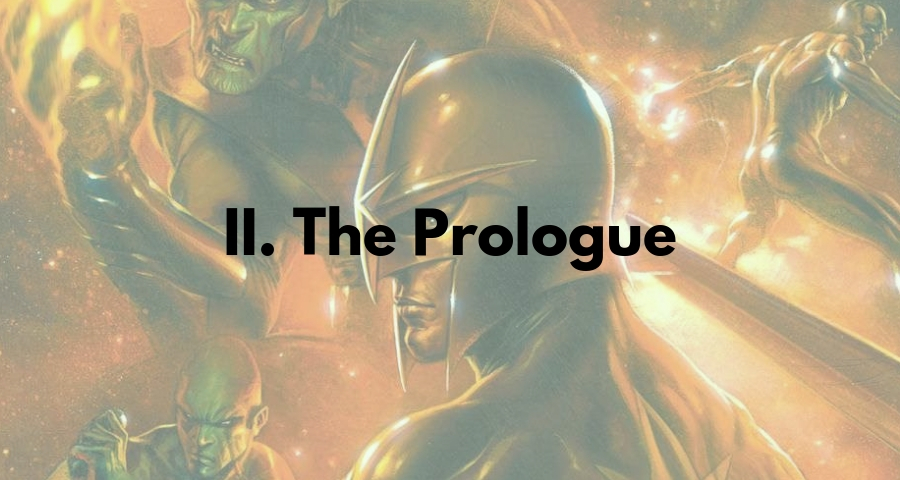
They had approval and a structure. But then it was time for the hard part: putting the actual comic together, from the cast and creators to the actual creation. The Prologue was the first port in the storm, and it was a mostly easy project to get together creatively. Giffen would write it, but who would provide art for it? It all started at the front.
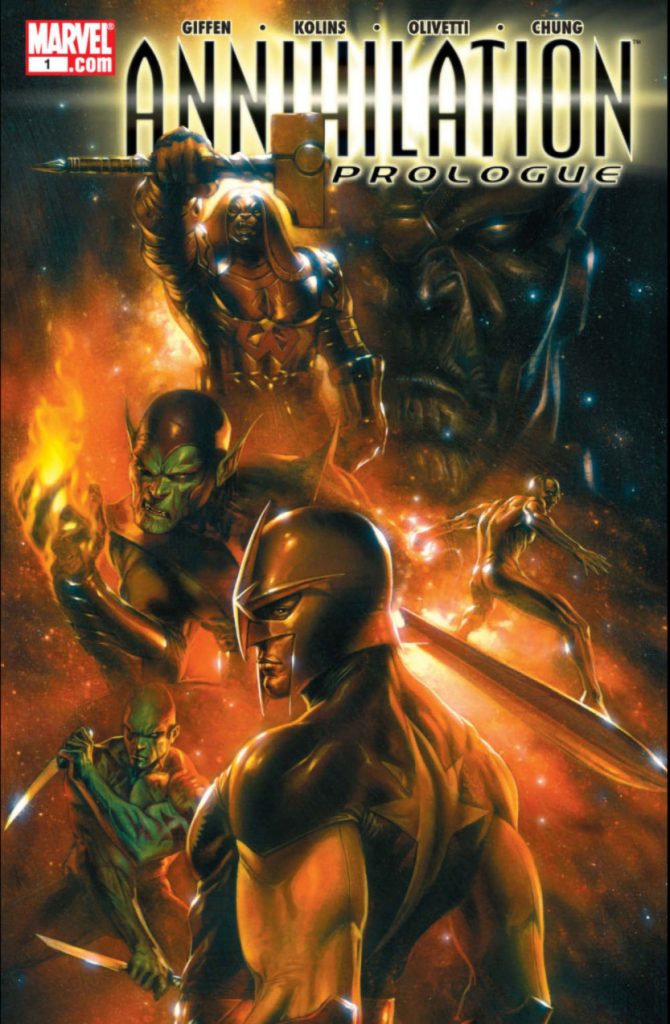
Schmidt: The first artist I talked to was Gabriele Dell’Otto.6 The first thing that he did was that Prologue cover, which I said, “I need this to be the movie poster. I need this to be the Star Wars of the Marvel Universe.” Once people started to see that, it clicked. “So that’s what this is.” They’re darker, they’re painted, they’re epic looking. So when he did that, a lot of hesitation went away.
Next were the interiors for the book, which quickly became a moving target. With such a narrow timeframe from Drax’s completion to launch, deadlines were tight. The first section of the Prologue was drawn by Ariel Olivetti, who had to be replaced for the remainder of it to ensure it was completed on time. In stepped Scott Kolins, an artist who jumped at the chance to work with Giffen, even though the famed writer/artist provided unique challenges to Kolins with this issue.
Scott Kolins (artist of Annihilation Prologue): If I’d thought about all the armadas and space stations, I might’ve hesitated on agreeing to the project. It was challenging to work all that into a page, but rewarding too. Thankfully Keith’s system is to draw breakdowns, which helped make sense of the insanity on the page so I could concentrate on designs and drawing a billion ships.
With the artists sorted, it just came down to telling a good story while introducing the key players and what they faced, all in one prologue. And they had to find characters they could use that no one else was using. Oh, and they had to sell everyone on what was perceived to be an unsellable side of Marvel at the time. No pressure.
Schmidt: The toughest issue I think for us was getting to the character stuff while also explaining what the whole event was. And we had 48 pages in the prologue to do that. So we had to establish the stakes, tell you what this thing was, tell you who it was going to be about, and make you care hopefully in 48 pages. And we had to seed Thanos even if he doesn’t become a major player until 8 months later or whatever. We had to introduce the four characters in the mini-series. We had to set all that up in the first issue and get people onboard. Scott who drew it and Keith who wrote it, those guys just hit it out of the park.
Giffen: It was choosing characters that we thought were strong but also characters I could fuck with without hearing another creative team screaming at me. That fueled a lot of what went on in the book. I told Andy at one point that if we need a character to do certain things, I’d rather make up one. That’s why a lot of the other characters in the book were made up.
That’s where a long forgotten character, who finally entered the Marvel universe in full within Giffen’s run on Thanos, came in. While not a key player in the prologue, he was an essential part of the main story as well as this universe going forward – and beyond.
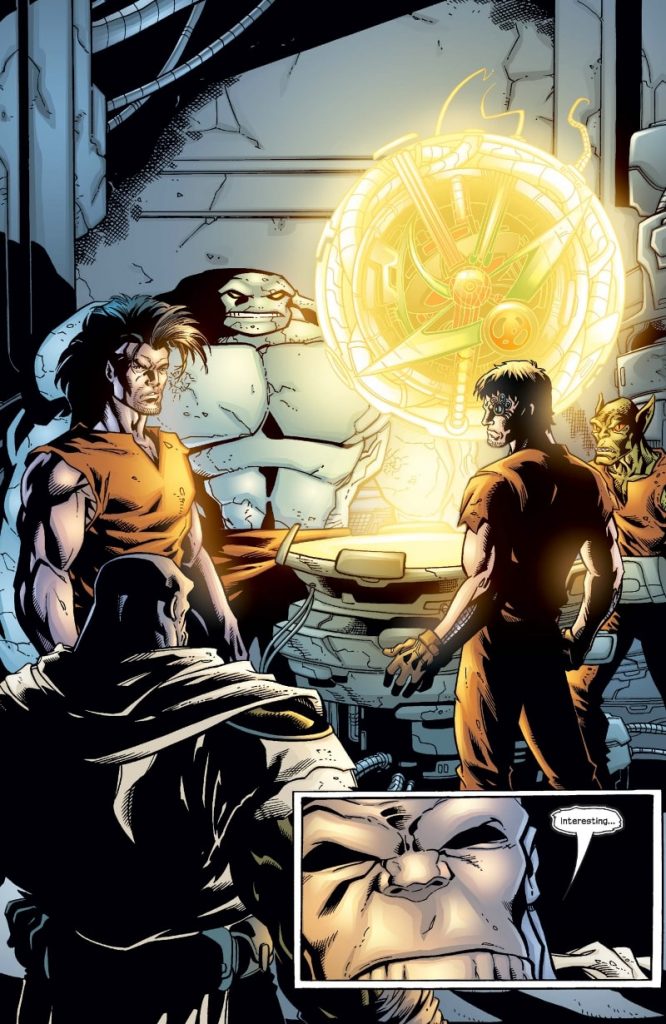
Schmidt: I had read the Star-Lord comics as a kid. I didn’t remember he wasn’t in the Marvel Universe. So Keith brought Star-Lord into the Marvel Universe in the Thanos series and brought it up to me. “What do you mean Star-Lord is not in the Marvel Universe?” “This is the first time he’s appeared in the Marvel Universe.” “I’m pretty sure he’s been around since the late ‘70s, Keith.” (laughs) And then I went back and read his original appearances and I’ll be darned.
Giffen: That was a John Byrne creation and John did it wonderfully. It was a great character. But I was more interested in Peter Quill than I was in Star-Lord. So I deliberately avoided showing him as Star-Lord. I had people constantly saying to him “Aren’t you Star-Lord?” and him sort of grousing about it.
Schmidt: I asked around in the offices, “Does anybody care about Star-Lord?” And everyone was like, “No.” And now Star-Lord is in the Marvel Universe.
Naturally, an essential part to any event is the villain. And Annihilation had a particularly great one – introduced in one of the great final pages from any Marvel comic – that was at least in part decided by Schmidt’s desire to avoid being compared to previous cosmic events7 because of their choice of antagonist.
Schmidt: Because this was all being done in one office, I had to basically find a villain who was one of our office’s villains.8 But if you look at most of the cosmic guys, there’s Thanos and Galactus, and I didn’t want the villain to be Thanos and look like a thing that had come before. I had always liked the way Annihilus looked. And this guy rules a dimension. He should be one of the big bads of the Marvel Universe. He looks awesome. Theoretically he has a whole dimension of minions. But he just wasn’t like that.
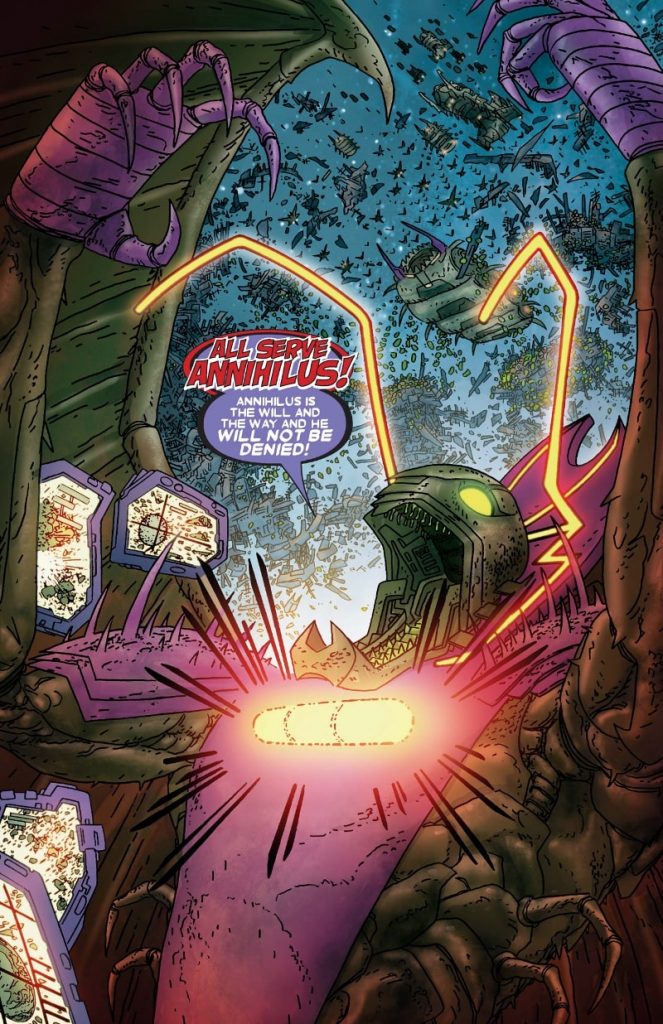
Giffen: Well, the whole thing with a villain like that is he’s single minded, he has the power, he can’t be reasoned with, he can’t be talked out of it. That’s a villain.
Schmidt: One of the things that we talked about a lot was, do you or do you not reveal Annihilus as the villain in (the prologue)? My feeling was that we were going to reveal it was Annihilus. And the argument I used internally that seemed to convince everybody was “It’s named Annihilation. Everyone is going to know it’s Annihilus as soon as it’s announced.” And the funny thing is no one guessed.
Kolins: I remember some discussion about that last splash page (that introduced Annihilus). Keith had a full body splash and hadn’t really shown Annihilus at all on the previous pages – just some close-cropped silhouettes. I decided to show his full figure on the previous page – albeit not detailed – and push in for real emotional impact on the last splash. It was also up to me when I pushed Annihilus’s design more monstrous, and thankfully Marvel did not have a problem with that.
The issue found Annihilus’s Annihilation Wave breaking out of the Negative Zone and immediately wreaking havoc, decimating the Kyln,9 Xandar and the entirety of the Nova Corps (save one Corps member in Richard Rider) in the process. Expectations were low for the book. It was a cosmic title. Those don’t work. However, this one did, and that briefly complicated things for Schmidt.
Schmidt: When the Prologue issue of Annihilation came out, it sold way more than they expected.10 Then I remember there were a lot of meetings all of a sudden. I was defending stuff that nobody had even questioned before and that was probably the hardest time period. We were sending all four issue #1s out the door, and all of a sudden, everything was under a microscope for like a month. That was a difficult time, and I’m very grateful for Tom Brevoort especially during that time. He helped me figure out how to navigate a lot of that stuff in a way where if he hadn’t been helping me I would have done something and gotten kicked off the project or ruffled more feathers than I needed to or did.
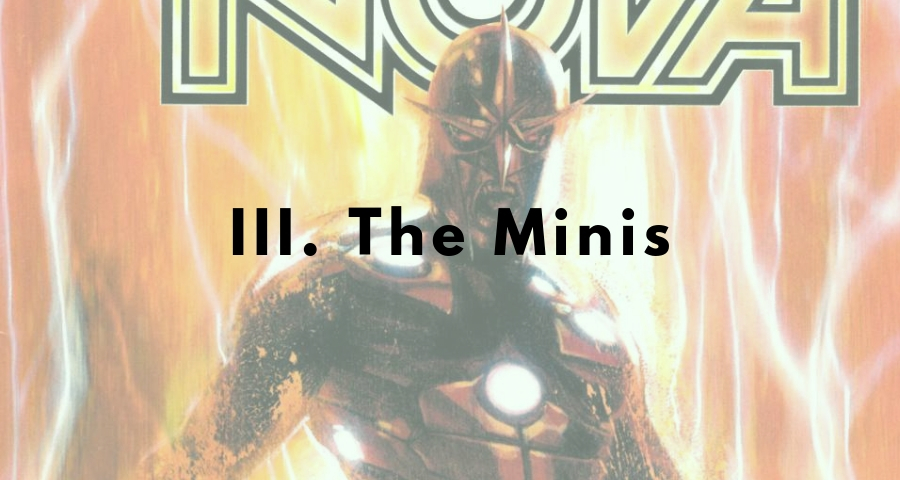
After the Prologue, there were four single character centered mini-series that fed into the core story. Their objectives were less plot based – the story was really defined by the events of the Prologue – and more about building up characters who were at the time C-listers at best besides the Silver Surfer.11 Schmidt had to find the right creators – on a dime, as Marvel set a pretty tight budget for the event 12 – with the right ideas for this quartet of characters. Silver Surfer was easy, as Giffen tackled that mini. Up next was Nova, which was co-written by eventual Marvel cosmic stalwarts Dan Abnett and Andy Lanning.
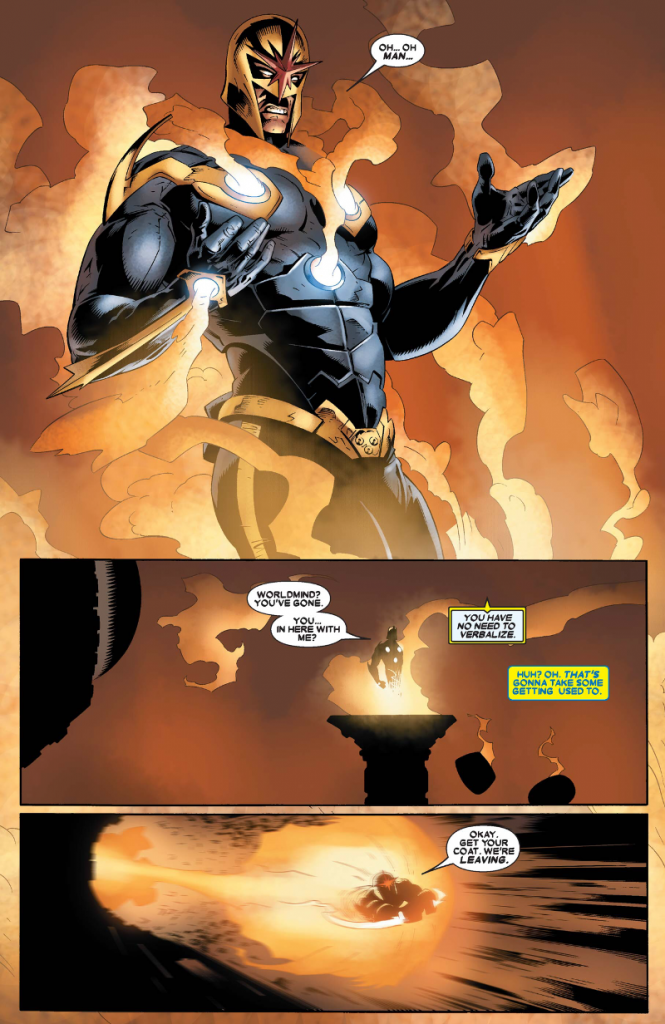
Schmidt: We knew at the beginning that Nova was the main character. This was Nova’s story. We made the prologue zero in on him and just make him this kid so that when all of these bad things start happening around him, hopefully the idea was to get the readers caught up in (the idea that) this kid is in shock because he’s never seen anything like this and he’s way out of his depth.
Abnett: With Nova, what I wanted to do was to make part of his deficit as a character the fact that he was aware of his own lameness. The fact people didn’t take him seriously. In terms of his power levels, he should be a first division hero in the Marvel universe. But he was clearly never really regarded as such. That’s not just an audience perception. That’s an in-universe perception, where the Avengers and everyone else were like “Oh, it’s Nova. He can come along I guess.”
Lanning: That whole idea (was) he had to be at his absolute lowest low in order for him to find out that he was a hero again.
Abnett: It was fulfilling (the) potential of his character because he had an important job to do. It was really about him embracing his own failures and his lack of fully achieving his potential that made him a really interesting character to write.
Schmidt was a fan of Abnett and Lanning’s work together on Legion Lost, a 12 issue series they did at DC, as well as a Legion of Super-Heroes run that found the duo reinventing Ra’s Al Ghul for a new era. That fit what Annihilation was trying to do perfectly. It worked for Abnett and Lanning, as they had already been pitching Marvel on a Nova series before this event. That made the project appealing. The pair found it to be a good working experience with Schmidt and Giffen.
Abnett: Andy (Schmidt) had a very good road map of what he wanted the event to be and how it should all fit together. I think in the original version the meta story was written and there were these sort of compartments where the different mini-series would fit in. As long as the joining beginning and ending parts connected to the main story, there was freedom within that.
Schmidt: Even if I’m the architect, I have to leave a lot of room for Keith and Dan and Andy and the artists.
Lanning: We really went for it. It gave us that great opportunity to play with the whole notion of the Worldmind and Nova Prime powers. It was a great starting point and a nice jumping off point for us to really push what Nova is and was at that time.
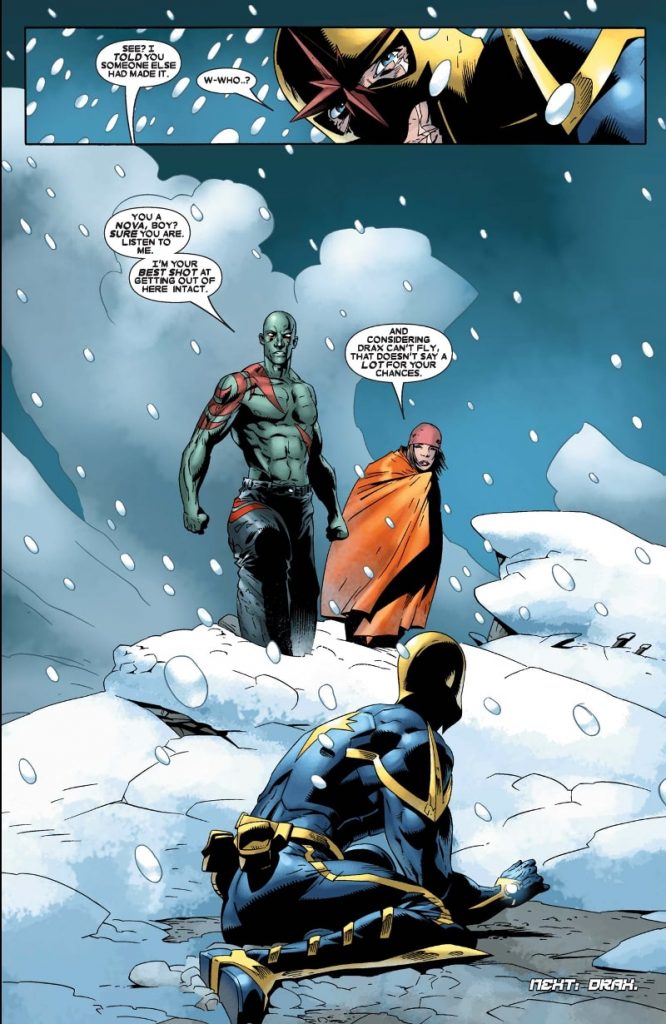
Nova meeting Drax and Cammi in Annihilation Nova #1 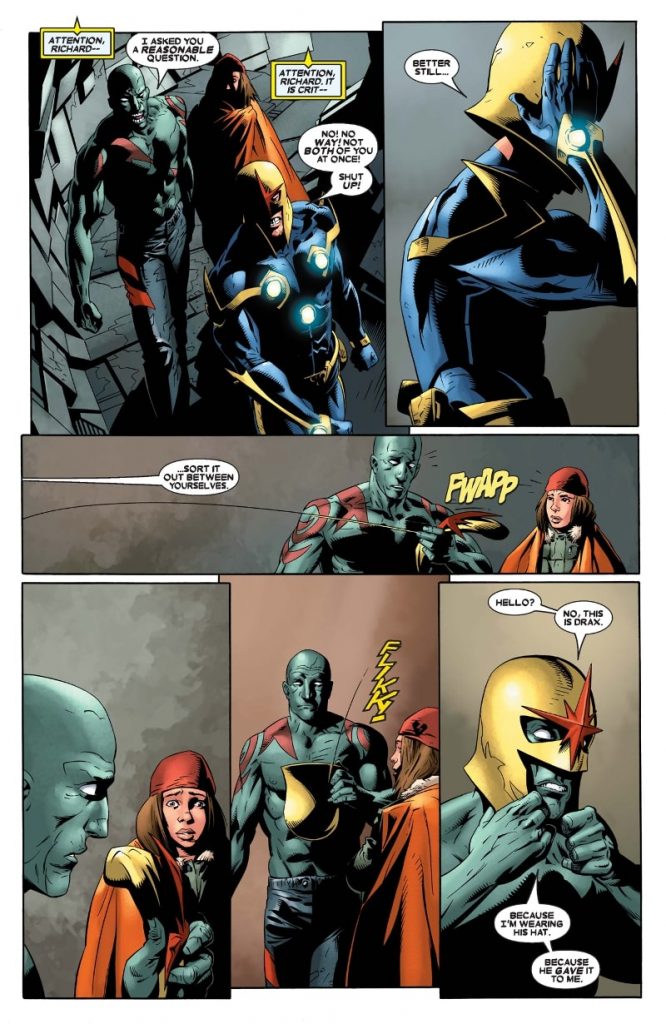
Drax and Worldmind coming to terms in AN #2 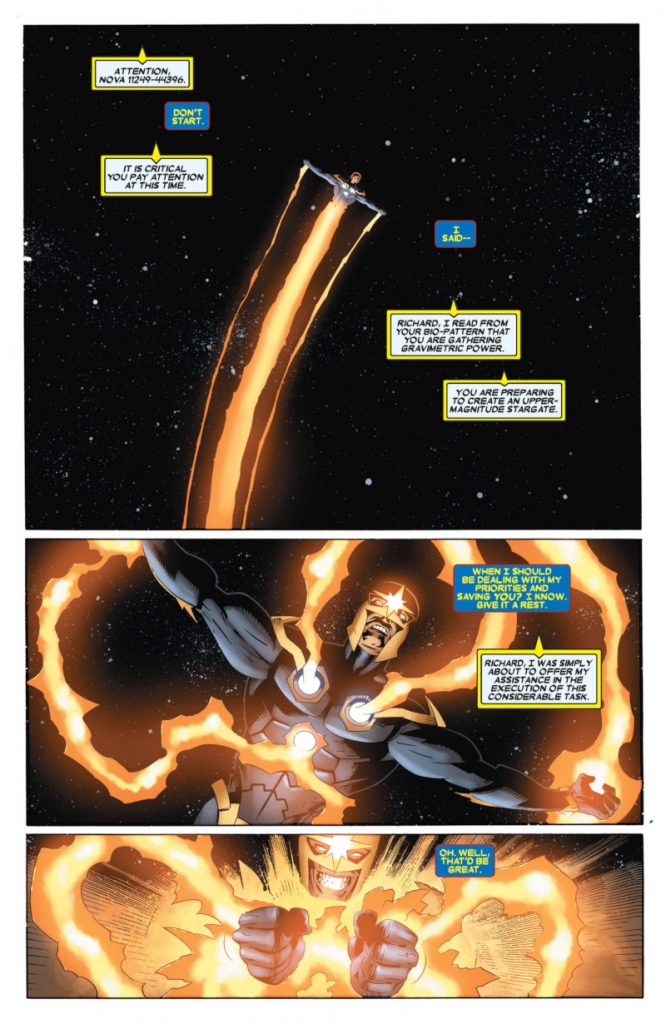
Worldmind helping Nova in AN #3
The focus of this mini was tearing Richard Rider down and building him back up. Nova had assistants to get through that process, with Drax and Cammi 13 returning here, and the manifestation of the Nova Corps’ memory and power – Worldmind – playing a key part. That trio helped Abnett and Lanning take Nova where he needed to go.
Abnett: (Drax) was sort of the antithesis of everything Richard wanted to be. Richard wants to be this respectable, clean-cut uniform wearing cop. And Drax doesn’t care. Drax doesn’t care what he looks like or what he does. He doesn’t care what people think of him. He just gets on and does what he needs to do. He was a great foil because Drax in his own right was better at being a hero at that point than Richard was, yet Richard was more obviously a respectable hero than Drax was.
Lanning: At this point Thanos was off the table. Whenever Thanos is off the table, Drax has no mission anymore. It was the idea that you’ve got someone there who is obviously incredibly capable. He has years of training behind him and (was) a little bit aimless. It gave him a focus.
Abnett: On the other side you have Worldmind, who obviously is the ultimate mentor. Both Drax and Worldmind through the course of the story invaluably provided us with cool, in-story ways of delivering interesting exposition. Which is vital in a cosmic book because there is so little frame of reference to understand what is going on because it’s not set on Earth and you can’t see familiar things around. You have these voices literally telling him stuff so the reader can understand what is going on.
Lanning: To our knowledge, no one had ever taken the full force of the Worldmind into one being. That gives you the option to supercharge his powers. Explore new ways of doing things with him that weren’t “Whoosh! Here I go really fast!”
Abnett: They’re not quite and not simply the angel and demon on his shoulders, but that seemed to be how they worked in terms of driving him forward. Almost to the point when he goes, “Well I’m not going to do what either of you are saying, I’m going to be me, but I’m going to be a better version of me.”
Lanning: Talking to Keith about it, he got very engaged and excited about what we had done and sort of ramped up Nova’s role within the main story, which was really cool as well.
Relative to Silver Surfer and Nova, the other two mini-series leading characters were nobodies. That was an essential part of how Super-Skrull’s 14 story came together for writer Javier Grillo-Marxuach.
Javier Grillo-Marxuach (writer of Annihilation: Super-Skrull): When Andy got in touch with me, he was like, “We’re going to do four characters!” And I was like, “Great, who are they?” He goes, “Well, there’s the Silver Surfer.” “I’d love to write the Silver Surfer!” “Whoa whoa! That ones going to be Straczynski.” “Oh, okay. Well, what else do you have?” “Well, we’ve got Nova.” “Who’s Nova?” And he goes, “Well, they’re sort of like the Green Lantern Corps.” “That sounds really great. I’d love to do that!” He goes, “Well, we have somebody else doing that one.” “Well, what do you got?” “Well we’ve got Ronan the Accuser,” and I’m like, “Who the fuck is that?” (laughs) And he goes, “Well, he’s this Kree Accuser,” and I’m like, “Next.” “And we’ve got Super-Skrull, and he’s the guy who has failed to beat the Fantastic Four even though he has all their powers.” And I’m like, ”Oh…okay.”
Schmidt: (Grillo-Marxuach) was a pretty big name in TV and film. He was the only guy that wrote for the first and second season of Lost other than the creators of the show. And his episodes were really good. He and I hit it off. The fact was, he was stoked to do a Super-Skrull book…and was legitimately excited after not getting Silver Surfer and Nova. (laughs) 15
Grillo-Marxuach: It was sort of in the contemplation of why the Super-Skrull failed so frequently even though he was evenly powered with the Fantastic Four that I even came up with the idea for how to do the book and what to do with the book.
Grillo-Marxuach really connected with the idea that Kl’rt (the Super-Skrull’s name) was effectively the Buffalo Bills of comic characters. It made him think, “’What would it be like if you were the pride of an entire civilization that was task built to defeat the Fantastic Four and you just never could do it? Imagine if you had 30 years of failure on you.” The whole story stemmed from his take on the character from that first call with Schmidt, even if Grillo-Marxuach eventually found him to be a “poignant” character in Kl’rt’s efforts to redeem himself. Fittingly for an eternal loser like the Super-Skrull, Grillo-Marxuach killed him in the end. It didn’t last long.
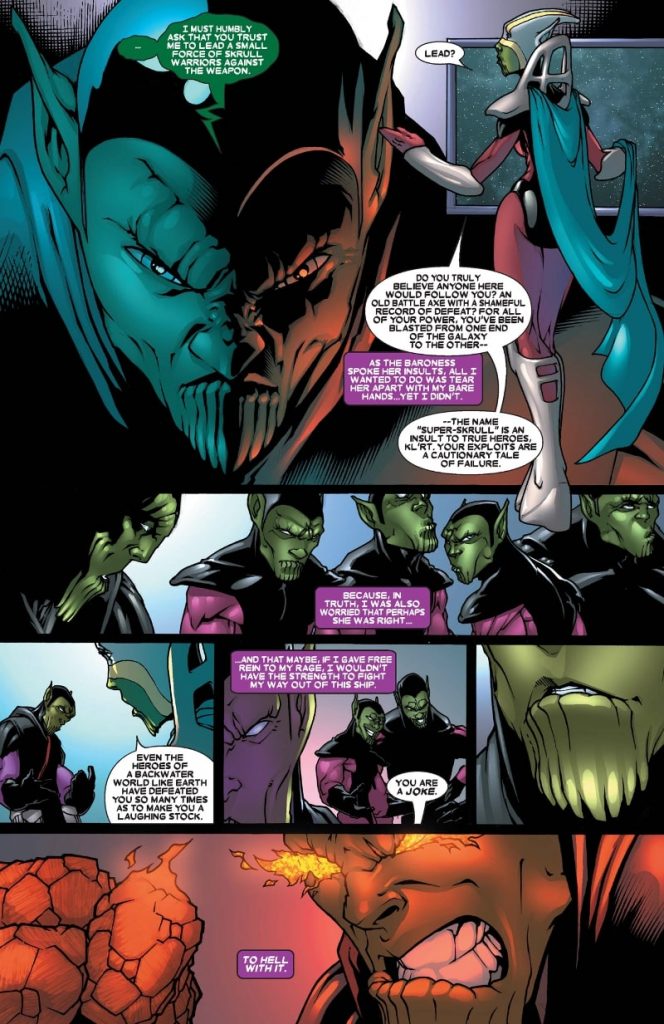
Grillo-Marxuach: When Andy first called me and described Super-Skrull to me and I had this idea of “What if the whole idea was him being a huge loser?” And also, “What if the end of it is we kill him?” One of the things you never see in these events and the satellite mini-series, those characters fed into the main series, and I thought, “Wouldn’t it be cool if we fucking kill him?” (laughs) One of the things that Andy admitted to me is that, “I think you did too good of a job bringing him back because they want to put him back in the series.”
Schmidt: I think (the Super-Skrull’s resurrection) evolved over time, and I suspect it was because Keith wanted that buddy buddy stuff (between the Super-Skrull and Ronan), which admittedly was great, so we had to bring Super-Skrull back for that.
Grillo-Marxuach: It’s been a while since I thought about this material, and just thinking about it now and what those conversations were like, it sort of gives me some appreciation of what a weird choice that was. (laughs) My mini-series ended 50 years later with them building a statue of him, so I certainly thought he’d stay dead.
Lastly was Ronan, the other half of the odd couple formed in Annihilation with his sworn enemy, the Super-Skrull. He was an important character to include for Schmidt for much the same reason that he wanted to use Annihilus: he saw untapped potential. The person who wrote the series was someone Schmidt was a long-time fan of in Simon Furman, the famed writer of Marvel UK’s Transformers comics (and later the main series), who hadn’t worked for the House of Ideas in some time and quickly jumped at the chance to return.
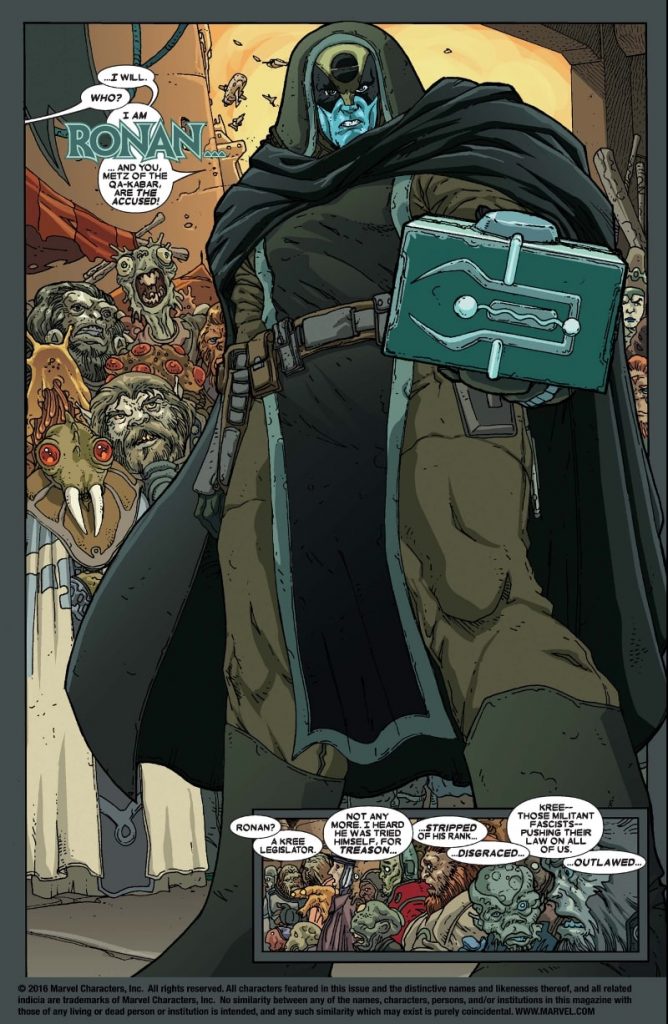
Schmidt: I always thought Ronan was super cool and never really was fully utilized. He looks awesome. I love how strict he is. The loyalty to the Kree when (we) all know that the Kree are the jerks of outer space. There are so many different things about Ronan that I thought were so cool that were never really explored very much.
Simon Furman (writer of Annihilation: Ronan): What I loved was not a huge amount had been done with him. He wasn’t one of the key players in the Marvel cosmic universe. And that’s always very attractive to me because suddenly you can start to pad that character out and do interesting things with him hopefully.
Ronan was, well, a ronin at this point in Marvel history, as he had “been cut loose from the Kree,” as Furman shared. This gave them something to chew on as they headed towards Annihilation.
Schmidt: The take on the character that Simon and I discussed was a kind of Judge Dredd in space.
Furman: (Ronan) very much had been a creature of orders and structure, and suddenly he wasn’t, and that kind of felt like a fertile ground to build some character. He’s out of his comfort zone and still trying to hold on to some kind of authority. But it’s all a sham. He has no authority anymore.
Schmidt: We needed to establish that he was the unmoving center. We can measure how things have changed by Ronan. The idea was to establish that he doesn’t change, no matter what. So that when he teams up with Kl’rt in Annihilation – teams up with a Skrull, his most hated enemy, and the most hated of his most hated enemies – this was supposed to signal a giant shift in the character and the world they inhabit if he was willing to do that.
Furman utilized forgotten players from Marvel cosmic lore to build out his cast. You could say his usage of characters like Gamora,16 Nebula and Korath started them on their path to being featured in the Marvel Cinematic Universe.
Furman: Immediately I’m attracted to the ones who aren’t being used, who have sort of been idle for a while and you could do something with. It’s not just a random selection. You hope they’re going to serve the story. That they’re going to open up some other facet of your main character.
Schmidt: I thought Simon gave us a really strong basis to start Gamora off with. He really took to heart everything that we discussed and brought his own sense of humor and style to it.
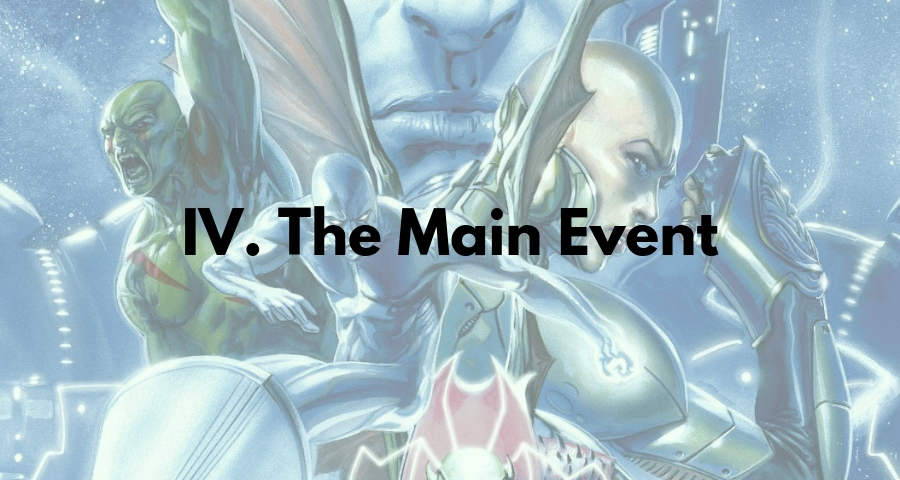
Annihilation at its core was a six-issue mini-series, and one that tells the tale of the whole of cosmic Marvel teaming up to stave off Annihilus’s Annihilation Wave and save the universe. If you’ve read a comic, you likely know how it plays out in general. But thanks to Schmidt, Giffen and series artist Andrea Di Vito, it became something greater. Di Vito was thrilled to have the opportunity.
Andrea Di Vito (artist of Annihilation): I was tasked to “restart” the Marvel cosmic universe after so many years of a semi-dormant state. I was humbled and honored; I couldn’t really pass up the chance.
Schmidt: I had worked with Andrea and been a fan of his since Thor Ragnarok (during) Avengers Disassembled. I loved him on Thor Ragnarok and Laura’s 17 coloring over him. He’s got a classic John Buscema-y style and he never misses a deadline and he’s super nice and funny and super excited.
From there, the team executed the story, and it was one driven by characters in a way events often aren’t. Quite a bit of that stemmed from the minis that preceded it.
Giffen: When you do these kinds of events, you gotta trust the other creative teams who are doing the ancillary stuff. When it came time to knit it all together, I looked through their stories, and if there were little bits here and there that I could use to smoothly move into Annihilation, I did.
Schmidt: One of the things we were careful to do was make it about the characters. Who cares what happens to Skrull World 74 if there’s not someone on there that you genuinely like or enjoy or have some sort of stake in whether they get off the planet or not.
Giffen: Every one of the characters in Annihilation responded because they had no choice. Take Nova. His entire organization was destroyed. He has no choice. He could have run away and hid somewhere or just taken off the uniform and gone to Earth. Richard Rider decided to continue to be Nova and dive right back into this maelstrom when he could just go home. That’s an act of heroism. The individual characters had a reason for fighting. They had to repel. It just flowed from there.
The tension came from its villain and his titular wave of minions, whom Di Vito and Giffen thrived with.
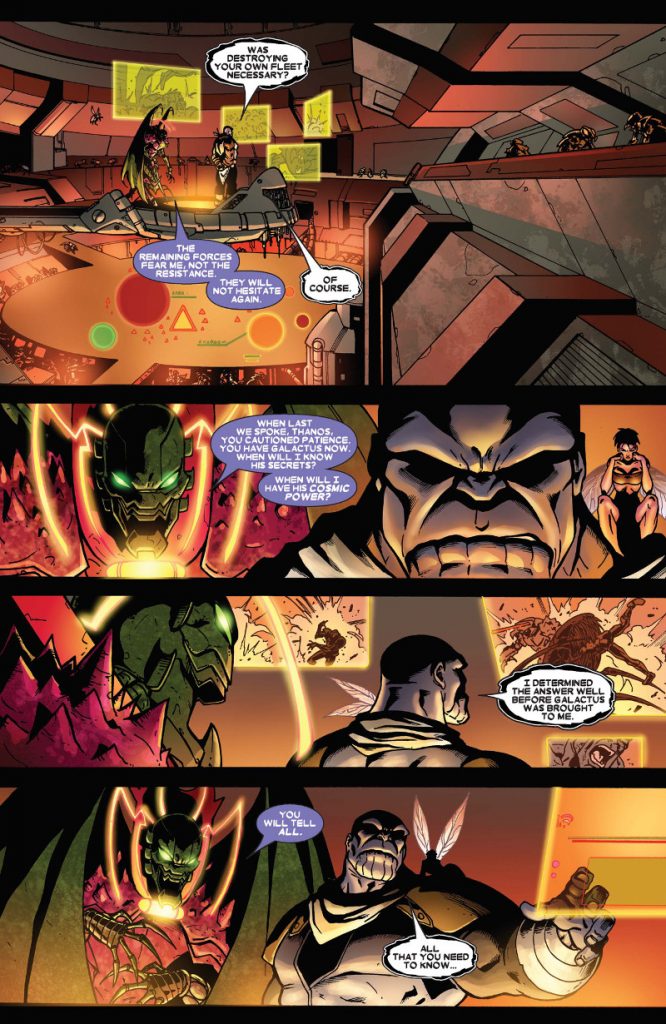
Di Vito: I remember keeping him hunched as much as I could. I wanted to portray (it) as madness, paranoia, unquenchable thirst for power. I always used the light source coming from the Cosmic Rod at his throat to underline his madness. Nothing like a light from below can bring such a level of tension on a character’s face.
Giffen: They always say the villain defines the piece. Once you come up with a good villain, you’re set. And Annihilus was a wonderful villain. So we got lucky.
Di Vito: We had to give the reader the constant feeling that no matter what the heroes did, the Annihilation (Wave) lived up to its name. An endless stream of nightmares at Annihilus’ disposal, ships, literally anything I drew in those sequences was meant to give a sense of oppression and unavoidable doom.
The series itself was loaded with incredible moments, both big and small.18 But two parts stood out to me, with the first being purely character driven. At the end of issue two, Drax seemingly sacrifices himself to allow Cammi – his ward from his preceding solo mini-series – and others to escape an overrun planet. The final line – “He did it for her” – was a pitch perfect marriage of Giffen’s scripting and Di Vito’s art.
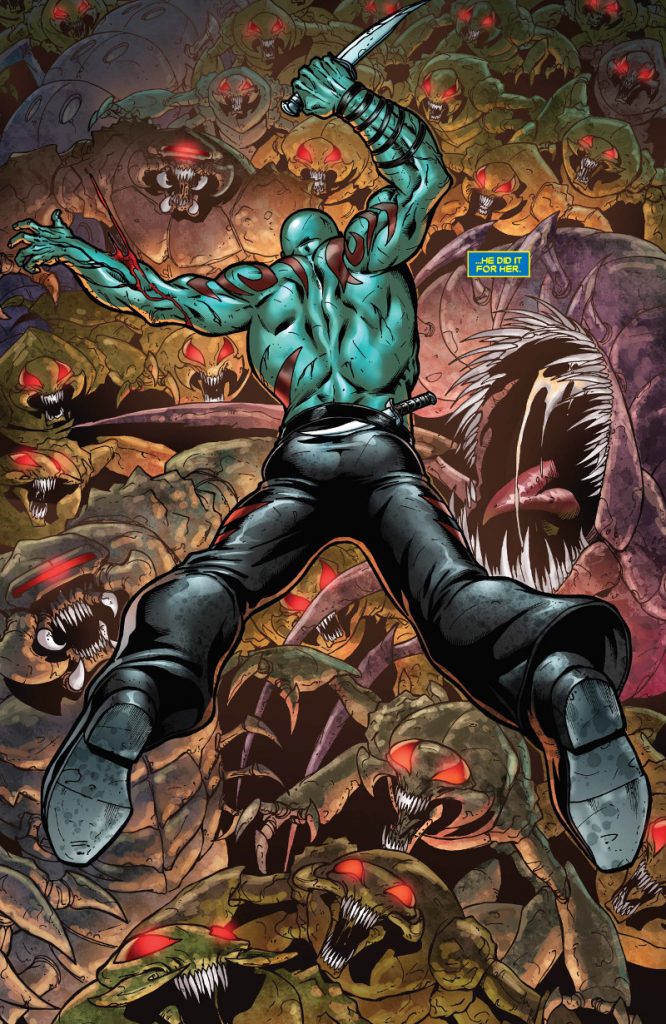
Giffen: I like that scene when Drax jumped in. “He did it for her.” That means in all this destruction and all this craziness going on around him, when it came to the ultimate moment, he did it for a little girl. It made sense. I think it enriched him as a character.
Di Vito: It was necessary. Annihilation is a saga composed of massive, over the top moments. If we never took the time to show the readers that these “Gods” battling impossible odds were still very much human, the whole story would have lost its heart. Drax is maybe the character that evolves the most in this story.19 We see him as a warrior, as a mentor and finally as a father once more, learning how to be a parent again thanks to Cammi’s presence.
The biggest, perhaps most unexpected moment of the series, though, came down to something previously unimaginable: Drax finally – finally! – killing Thanos.
Schmidt: That was part of us going, “This isn’t what you’ve seen before. This isn’t a Thanos story.” So when you kill Thanos, and he doesn’t come back, I don’t think people really expected it.
Giffen: That was much more to me a Drax scene than it was a Thanos scene.
Schmidt: I wanted to kill him off not to take him off the map specifically, but I wanted to do it in a way where Drax finally fulfilled his goal, which we essentially restarted in the Drax mini-series. But I didn’t want you to really root for it. So when Drax finally kills him, it’s in a moment when Thanos is going to end the war and beat Annihilus. And that opens an opportunity up for Drax to kill him, so it’s like, “Oh, he did it? Couldn’t he have waited 20 seconds?” (laughs)
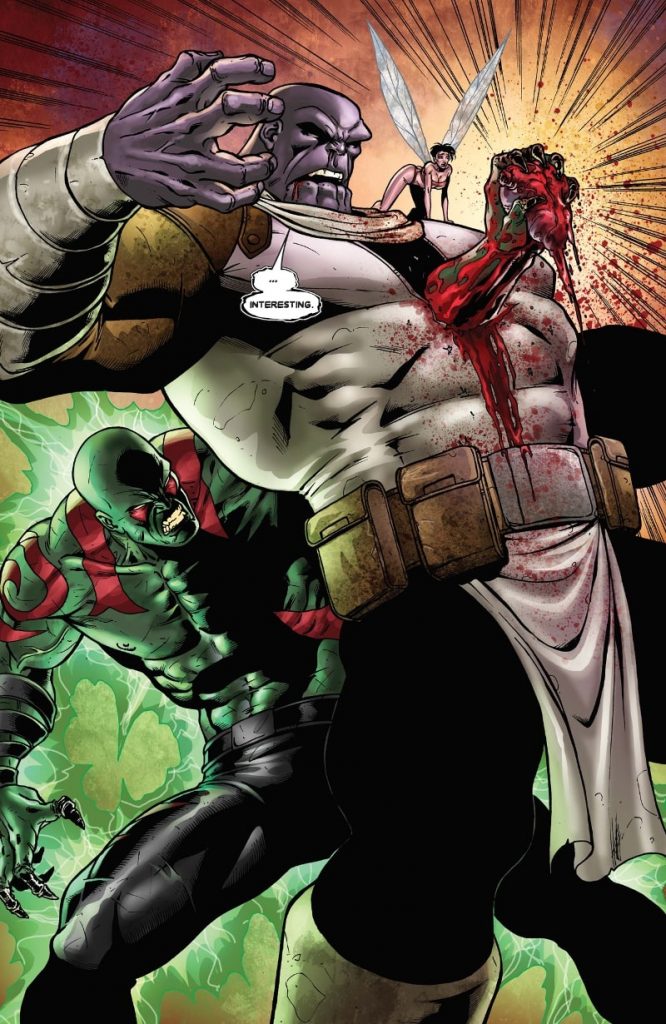
Di Vito: I remember reading the script and immediately thinking “Yeah, I can already feel the powers that be asking me to tone down this scene. No way they will let us do this.”
Giffen: I was surprised we were able to get away with it. But on the other hand, I wasn’t surprised because nobody ever really dies in a comic book. But for that moment, we had our moment.
Di Vito: I decided to go for it guns blazing. So I had Drax rip out Thanos’s heart as plain as it could be portrayed. When I sent the page to Andy, I was ready to wait for hours for feedback. I thought there would be a sudden meeting about that page, a discussion and so on and so forth. But five minutes later my inbox blipped. Andy had replied thus: “This is fantastic, it’s a punch in the gut of all readers (or through the chest in this case), wonderful!”
Brevoort: It’s hard to imagine these days when Thanos is at the center of the two biggest Avengers films, but at that point his star had fallen a bit. He was still a big character and a great villain, but he wasn’t so much in the spotlight as he later became. So Drax finally fulfilling his purpose and killing him was a portion of the Annihilation outline from a very early point, and I don’t recall that being in any way a controversial or even hotly debated idea. Villains get killed; it was very much a sense of being business as usual.
At its core, Annihilation doesn’t sound special. It has the Infinite Crisis structure. It has a lot of characters we already knew at its core. It’s a classic good versus evil battle. So what made it soar to the heights it reached, reigniting the cosmic universe in the process? There were several key reasons, forming the secret sauce that tied the whole thing together.
Giffen: A good event is only as good as the event. I think Annihilation as the event worked because the story was really too big to tell properly in just three issues. It wasn’t just aliens invading Earth. It was a threat to the entire Marvel Universe. The story had to be big.
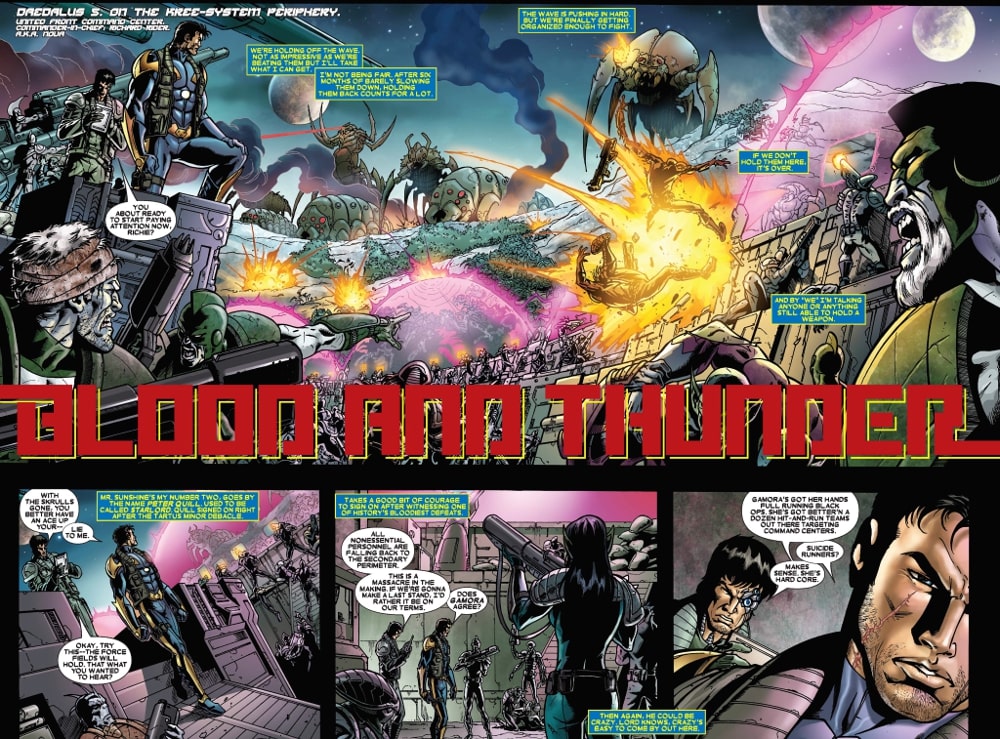
Grillo-Marxuach: I think what Annihilation did is that, because the cosmic universe hadn’t been around, you could actually read Annihilation as a story with a beginning, middle and end. If that’s all you read, it works. You don’t have to know that Drax the Destroyer was friends with the Scarlet Witch 55 years ago. You just pick it up, you read it and it’s a really great space opera story. It stands on its own. It’s not part of 500 other events that have the word Crisis in them.
Giffen: I think Annihilation, the issues can be read separately and you still get the whole story of the Annihilation attack. But the other stuff…it’s like you can make a great meal without the spices. But you know…a little spice never hurts.
Abnett: With the Marvel cosmic characters as they were then, (they) were not only at the bottom of the toy box, they were broken and no one cared. Which meant there was much more latitude in what we could do with these characters.
Lanning: I think there’s a certain fun to that as well from a readers point of view because it’s like, “Wow, anything can happen to these guys because they could quite literally do anything (they) want with them.”
Giffen: As much as I would love to stand up and say, “Annihilation was all my idea,” no, it was actually comics at its best – when you’re sharing an idea around and everyone is contributing and the end result was better than any one you could have done alone.
Lanning: There’s nothing better or more rewarding if you’re writing as part of event title to see your work being reflected by others. It’s almost like passing the baton around. That’s very creatively rewarding as a writer.
Schmidt: We did our absolute best to make sure everybody knew what was going on and had a say – especially with anything that had to do with their characters. And that’s not easy to do because it’s easy to go, “Oh, we decided this thing so let’s move, we have to keep these trains running on time.” It’s easy to leave people out. So we definitely tried not to do that.
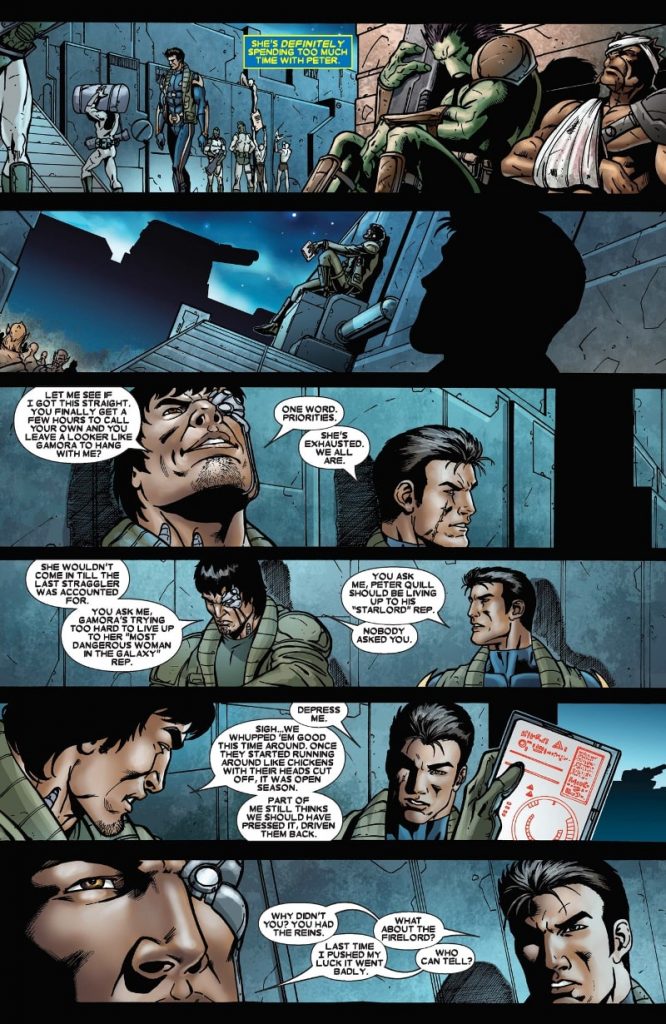
Abnett: Crossover events for any company usually fit into one of two distinct categories. They’re either overly controlled or completely haywire. And I think that somehow Andy’s editorial touch managed to keep the tight control so that it all worked and held together whilst allowing for the imagination to run wild and to shape it as we went along. I’m not sure how he did it. I remember it very clearly as being an unusual experience. There was an even amount of both freedom and direction.
Furman: I think a lot of the credit is Andy’s here. He really was very character focused. He wasn’t big story focused.
Grillo-Marxuach: To Andy (Schmidt)’s credit, this was a huge swing. Even though we were taking these underappreciated, underutilized characters, at the same time, it’s a, what, (six) episode mini-series with 16 offshoots? It’s a big commitment for a publishing company. I don’t think you get big swings like that without somebody saying, “Here’s the vision for this.” Someone has to sell the powers that be on why they should spend all that time and shelf space. I think one of the things I was impressed by with Andy was that sense of “this guy really sees this.”
Lanning: That (partnership between Schmidt and Giffen was) the other component that really kick started and blew the socks off of this. Because Giffen is like an ideas machine. (Andy had) the bigger bit of concept and giving that to Giffen and him going completely bonkers with it. That was a very fortuitous pairing. And it just gave you such great stuff to play with.
Giffen: If you like Annihilation, you like Andy Schmidt. It would not have happened if it weren’t for Andy.
Abnett: I think part of (Schmidt’s) vision was that if he got the right creators, those creators would run with that, and what he was dreaming of was things that he couldn’t imagine, but he could imagine other people imagining. He had built the structure and there were lovely sort of voids where great stories could happen. Maybe that’s the thing he really got right. To look for people who could do that and to encourage them once he started doing that.
Lanning: With Annihilation, it was really there was a fan base for it. There were people like myself who loved Marvel cosmic and they hadn’t been getting their fix. Annihilation gave it to them in spades.
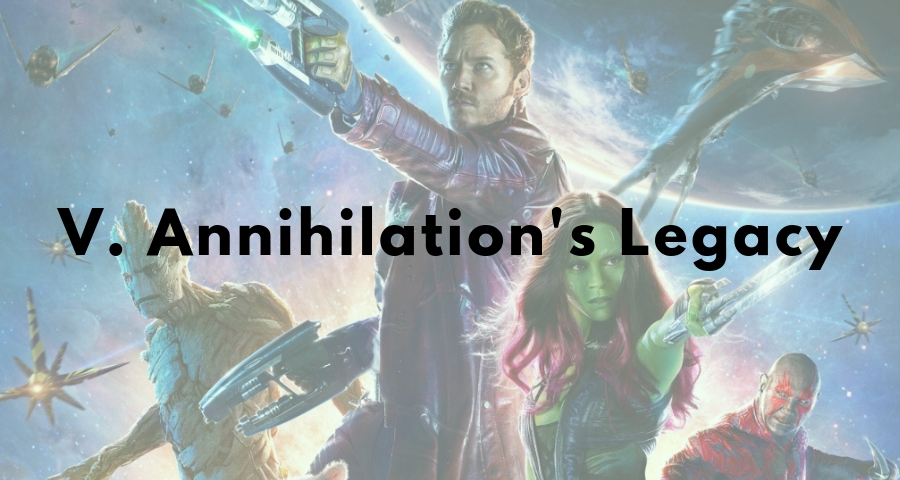
Annihilation reinvigorated the cosmic side of Marvel. While a Nova ongoing spun out of that first event, Marvel saw even greater potential and wanted to quickly build towards that. Within seven months, Annihilation’s sequel – Annihilation Conquest – arrived, but Schmidt and Giffen, the chief architects of the first event, were no longer running the show. Abnett and Lanning stepped in to write Conquest.
Schmidt: They promoted me and promoted Nick Lowe and had us run the X-Men books. I left the Marvel Heroes office. So that happened before (we knew) who was going to take over. I was in the X-Men office working on the X-Men books while still finishing Annihilation and essentially being tasked with building the Nova series and Conquest.
Giffen: I told Andy (Schmidt) after Annihilation was over, “That’s it. I never want to deal with something this big with these characters again. I’ve told my story.” So when Andy was looking for Conquest, he knew not even to approach me.
Schmidt: Conquest was being built in part to build Guardians of the Galaxy. So all the series proposals were in (and) all the writers were pretty much locked in.20
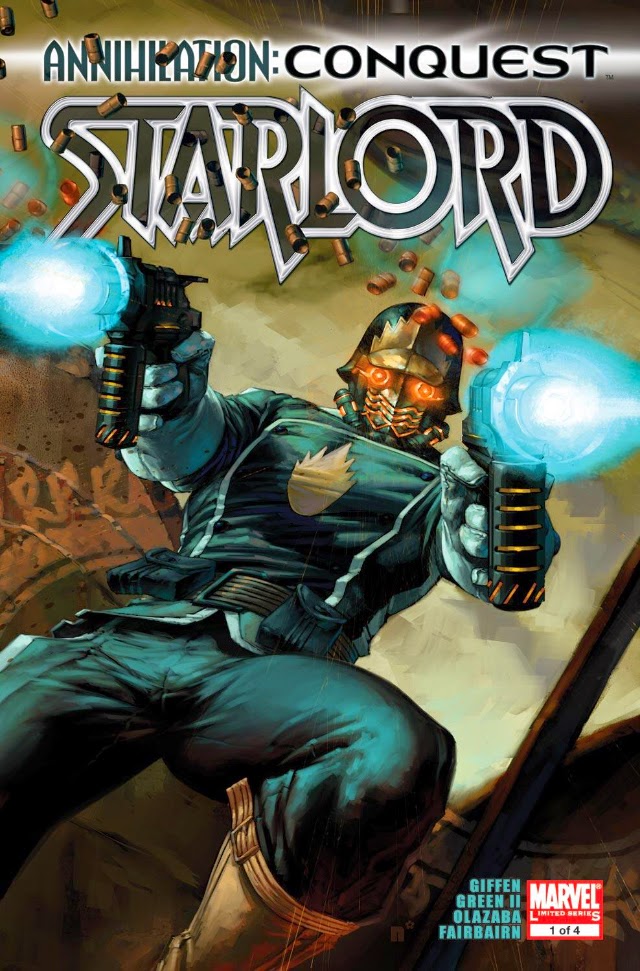
Abnett: I think I dreamed of the possibilities of what could be next. But I was under no illusions that it would. And therefore it was a delight to discover that the event had been so well received and that there was an appetite for more.
Giffen: I found out about Conquest after it was already approved and I was offered one of the mini-series. “I’ll take Star-Lord. Can I do it my way?” “Absolutely.” “Good, I’ll do Star Lord.”21
Schmidt: During the first Annihilation, Keith kept coming in the office and pitching Rocket Raccoon and Groot, and that Groot is Rocket’s houseplant he lives in. I would die laughing, but we (couldn’t) put (it) in Annihilation because it doesn’t fit the tone of the book. And he pitched it…I don’t know, six times? And we all thought it was great. (laughs) But after Annihilation was a success and people were bought into it, now we can loosen the reins a little bit and bring in some of these other elements.
Abnett: What we were building ultimately was a set of characters and an environment in which to tell the stories rather than one massive story. It was more about “this is a place to tell stories.”
Furman: We tend to sort of think of the Marvel cosmic universe as a thing now, but back then, it didn’t really exist in the same way. Obviously once Dan and Andy got on Guardians of the Galaxy and Nova, that’s where the Marvel cosmic universe really took off. The roots of that are all Annihilation.
Brevoort: It’s impossible to say for certain, but I don’t know that Marvel Studios would have been so quick to develop Guardians of the Galaxy as a film if not for the success of Annihilation and all of the assorted follow-up projects that came out of it. They might have—but it was really that success that made people pay attention to those characters and think about them in a certain manner.
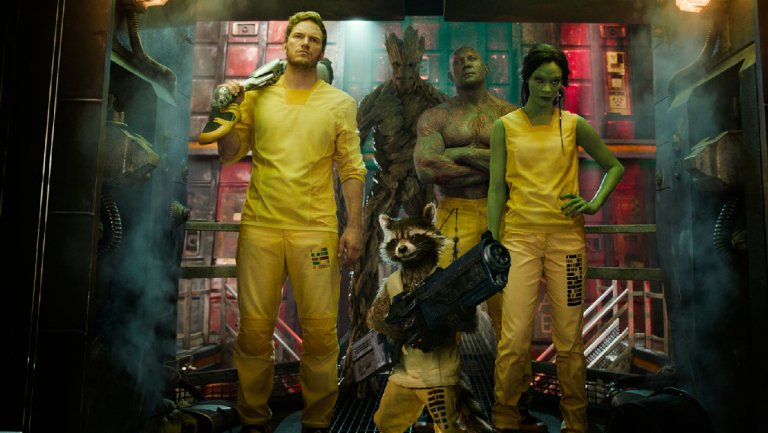
Abnett: To go from a world where when I started on the cosmic stuff at Marvel, if you mentioned Rocket Raccoon, they’d look at you puzzled because they had no idea who that character was, to going to a world where I walk down my high street and there are people with Rocket Raccoon backpacks…to see that transformation is an extraordinary thing.
Lanning: Given that the Guardians movie did so well, that opened up that corner of the cosmic side of Marvel even more, both in the comics and the movies. If you look at the whole leading up to Endgame now, it’s all cosmic. It’s got that wonderful cosmic background to it. None of that in my mind would have happened without Annihilation because it suddenly made people look at what was a very interesting area of Marvel comics that wasn’t being played with.
The legacy of Annihilation is immense for Marvel, both the comic company and the movie studio. It’s something that has a lasting impact in the way that few comics ever really do. Ultimately, it had a similar impact on the people making it.
Schmidt: All in all, it was one of the more collaborative experiences that I’ve worked on, which is a big part of why I look back on it as fondly as I do. Even though I did most of my editing of Annihilation after I went home. And after I’d have dinner with my wife and I’d go onto my computer in my bedroom and work for another couple hours…even though those were the circumstances which I did it in, it was fun. We had a lot of fun.
Di Vito: More than ten years later, I am still “the guy that did Annihilation,” a badge I wear with the greatest pride.
Abnett: It did give me a great sense of pride in what I had done. The effect of a story and a collection of stories was measurable beyond my own enthusiasm for them. It had an effect on the way the Marvel books worked, the Marvel universe worked. It had an effect cinematically. And that was rewarding and surprising to see happen.
Giffen: I’d say the books that I’ve done that come boomeranging back to me the most are the Legion of Super-Heroes, Justice League International, 52 and Annihilation. Those are the ones I field the most questions about. I’ve had four great things in my career, bucking the odds. That’s bucking the odds.
Lanning: If you talk to any comic creator, to know that you’ve got that playground is yours, so the cosmic books were ours alone for 3.5 years.22 We had all of that to ourselves. I think that’s the legacy. That becomes your calling card because you’ve honed it and you’ve honed your storytelling. And if you look back at other runs like that from other people, they become defining moments not only for the books, but for the creators. We were very lucky to have that chance…the opportunity to have the amount of time we had with those characters and playing in that little sandbox.
Furman: When I look back on it, “Look at that! I had those characters together.” That was way before the Guardians of the Galaxy took off and these characters became paired up in a more regular basis. It’s fun to revisit and say, “Hey, we were growing something there.”
Thanks to Abnett, Brevoort, Di Vito, Furman, Giffen, Grillo-Marxuach, Kolins, Lanning and Schmidt for talking with me for this piece. Interested in more content like this? Subscribe to SKTCHD.
Milgrom inked Ron Lim on Infinity War and Infinity Crusade, amongst many other projects he worked on with his childhood friend Starlin.↩
While it isn’t in the Annihilation collections, this arc set the stage for much of what was yet to come in Annihilation.↩
Writer J. Michael Straczynski↩
This was Drax the Destroyer: Earthfall, a four issue mini-series from Giffen, artist Mitch Breitweiser, colorist Brian Reber and letterer Cory Petit.↩
Part of that structure included keeping track of the timeline – dates were labeled as “Annihilation Day, Plus (x amount of days)” in the story, a system which was influenced by World War II – and if you pay close attention to some of the dates, Schmidt used favorite issues of Uncanny X-Men because they made remembering the numbers easier.↩
Dell’Otto provided covers for the Prologue, each mini-series, and the core title.↩
This was why they decided to not include Adam Warlock in the series as well.↩
That included The Avengers and Fantastic Four franchises.↩
The prison from the Guardians of the Galaxy movie, in case you don’t know.↩
The final issue of the preceding Drax the Destroyer mini sold just over 12,000 copies. The Prologue sold more than five times that, per Comichron.↩
Who, as noted earlier, even had a troubled past when it came to solo titles.↩
As a smaller event, it had less financial backing, and Schmidt pushed for a higher budget particularly on coloring, as he felt “a really good colorist was going to go a long way with a lot of the special effects we were going to be doing.” Marvel backed him in that effort.↩
Who really just relentlessly sassed Nova throughout the mini, helping in her own special way.↩
Who Schmidt viewed as a necessary character given how Annihilus immediately wipes out most of the Skrull race in the Prologue.↩
Side note on Grillo-Marxuach: He was only available because a Bart Allen-starring Flash title he was prepping at DC with artist Dale Eaglesham was unceremoniously nixed in favor of another from a different creative team at the eleventh hour.↩
Who was a supporting character in the main Annihilation comic as well.↩
That’s Laura Villari, Di Vito’s wife, who also colored Annihilation.↩
Two important ones not covered here: Galactus being bound and used as an energy source by Annihilus (and his eventual escape) as well as Nova literally reaching into Annihilus and pulling his insides out, killing the villain (briefly) and ending the war.↩
Or at least tied with Nova, Di Vito added.↩
Shortly thereafter, Editor Bill Rosemann stepped in on the cosmic books.↩
This was the Annihilation Conquest: Star-Lord mini from Giffen and artist Timothy Green II that launched the new generation of the Guardians of the Galaxy that we see in the movies.↩
After Annihilation, Abnett and Lanning co-wrote a Nova series, Annihilation Conquest, a Guardians of the Galaxy series, War of Kings, Realm of Kings, Thanos Imperative and Annihilators. They became the defining voices of the modern cosmic Marvel universe.↩
